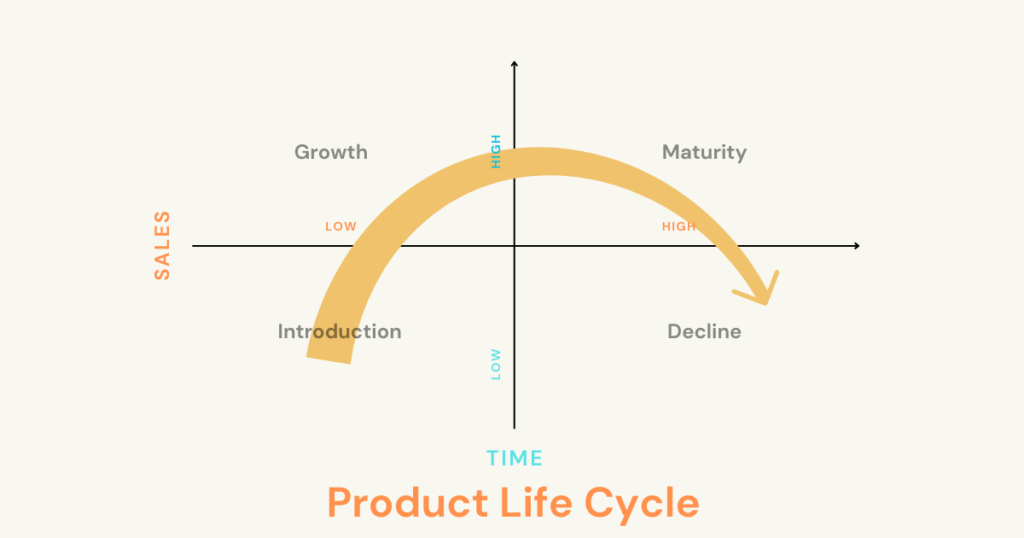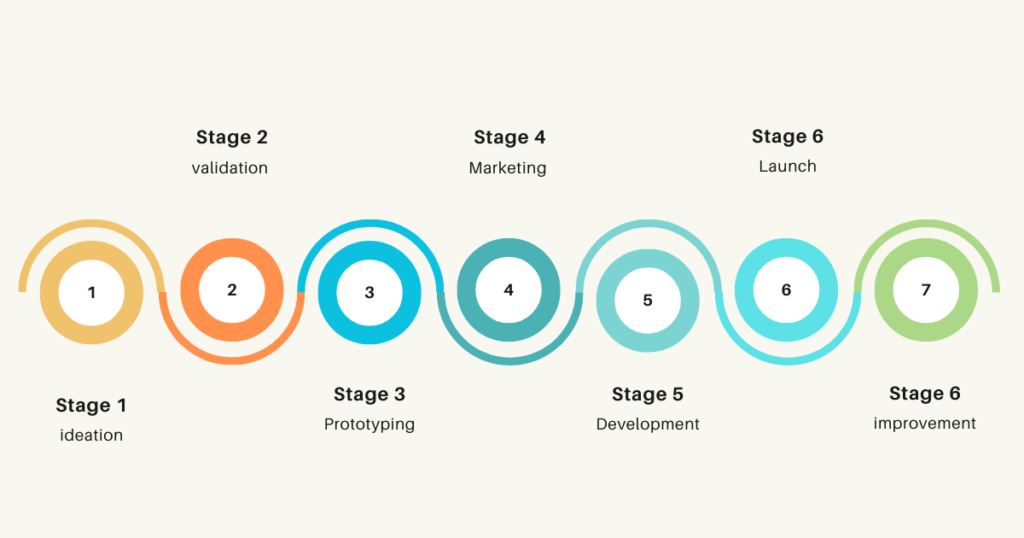Creating a new product is a difficult task. You will go over 7 stages of a new product development process, your customers will love.
A company that wants to create a successful product must use the product development lifecycle. The process of transforming an unproven concept into a successful product is known as new product development (NPD).
In any business, the main important point after the customer is the product or service that you sell. As a founder, you have to take care of your product (or service) to make it likely that the startup will ultimately be successful. Here I am going to share what are the 7 steps of a new product development process and how I apply them in my business so that you can also apply and see the magic.
The process of developing a product concept involves seven stages:
Brainstorming sessions are used in the idea generation phase to provide a pool of ideas, prioritizing customer problem-solving. The idea screening stage finds the most viable concepts based on their feasibility, profitability, and compatibility with business objectives. The process of turning these ideas into concepts and testing them with potential customers allows for feedback and improvements. Pricing, profitability, and the potential market size of the product are all determined by business analysis. During the product development phase, a prototype is created, followed by testing marketing in a small market, and finally, commercialization, which involves launching the product across the entire market with an emphasis on increasing awareness and increasing sales. It happens.
Let’s look at What a product development life cycle looks like
Product development life cycle
A company that wants to create a successful product must use the product development lifecycle.
Ideation, validation, prototyping, marketing, development, launch, and improvement are the stages of the product development lifecycle (you will learn about each in more detail later).
Teams can complete each step of the creative process more quickly and effectively if each step is laid out and leaves no room for uncertainty about what will happen next. Additionally, companies can maintain efficiency, competitiveness, and focus by using this systematic approach to developing new goods and services.
Teams involved in Product development
The process of developing a product from an idea to its commercial release and beyond is known as the product development cycle. Product managers, developers, designers, QA testers, and other departments of a company are all involved in this cycle. Anyone involved in product development has a simple reaction.
A representative from each of these departments should be present at important meetings. However, depending on the platform and objectives, smaller meetings of the teams will usually include all the marketers, all the designers, etc., or a combination of those.
The process from development to commercialization of a new product is known as the “product development lifecycle“.
On the other hand, you should also be aware of the product life cycle, which examines how goods change over time as their market share and sales volume increase or decrease.

The period from when a product is introduced to the market until it is removed from the shelves is called its “life cycle”. Management and marketing experts use this idea to determine when it is appropriate to boost advertising, lower pricing, enter new markets, or make changes to packaging. Product life cycle management is the process of planning how to continuously support and maintain a product.
In contrast, the product development lifecycle consists of seven essential stages: ideation, validation, prototyping, marketing, development, launch, and improvement. In the section that follows, you will learn about each step in detail…
Let’s dive.
The 7 stages of a new product development process
The process of creating new goods and services can be unpredictable. However, following a systematic new product development process can help you gain clarity and self-assurance in your creations.

Step 1: Idea
The product development life cycle starts with brainstorming. It all depends on coming up with concepts and looking at possible solutions to the issues. During this phase, teams will conduct market research, create prototypes, generate ideas, and create a business plan.
To get the most out of it, make sure you’ve done your homework. Your suggestions will be more appropriate to address your users’ issues the more information you have about them. Plus, you’ll be able to see more clearly what your product needs to do, helping you focus and respond more quickly.
- Read here: How to come up with great startup ideas
tips: Avoid considering feasibility at this time. Being creative is the main goal of brainstorming, so feel free to express yourself.
Step 2: Validation
You will evaluate the feasibility and market desirability of your proposal at this stage.
You will need to collect feedback from users through user testing, questionnaires, interviews, website analysis, and other methods. Once you have the data, you’ll be in a better position to determine whether people are willing to buy your item and what their expectations are.
- Explore more: How do I find my startup idea?
The best advice is to combine qualitative and quantitative research techniques. When combined, these paint a comprehensive picture of your product’s capabilities.
Step 3: Prototyping
Once you’re sure there’s a market for your product, it’s time to create a prototype.
This involves turning concepts generated during brainstorming into low-fidelity prototypes that your group can test on real users. If you are working on an app or website this is the wireframing stage. If you are developing a physical product, it will be in its early stages and have only the most basic functionality.
Use this step to get user feedback and validate your design. This is your opportunity to make any necessary adjustments or modifications. If you notice that people are complaining about problems or asking for special adjustments, you should go back to step two and follow the steps there before continuing.
The best advice is to prototype slowly so that you can gather input on your core user interface and individual features, rather than seeking input on the entire project.
Step4:Marketing
Once your product has been prototyped, you need to consider how people will learn about it.
To do this, draft a marketing plan outlining your approach to promotion and sales. Press releases, social media campaigns, content marketing and more should be part of it. Setting some KPIs will also help you track the effectiveness of your marketing campaigns over time.
With the help of user personas, all your data becomes somewhat more relevant. These ready-made characters essentially represent the different demographics that use your product. It is more beneficial to tailor your message to attract a “specific” user (or users) rather than trying to reach a large, faceless mass.
You also need to assess how you fit into the larger market and look at what your competitors are doing throughout this phase. What makes you unique? What can you do better than what others are doing? What actions are they not taking? All worthwhile inquiries to make.
Step 5:Development
At this point, everything comes together as you have developed a prototype, designed your marketing approach, and validated your idea. Now it’s time to create the actual product.
Creating something more significant than your wireframe or prototype model is the work of the development phase. This can involve anything from 3D printing to coding, depending on what type of product you’re making.
It is important to be agile during development and iterate rapidly. This includes keeping an open mind to modifications inspired by user feedback during testing and ensuring that the technical and design teams are in constant communication with each other. Any possible way to do this? Through an MVP.
An MVP, or minimum viable product, is an early-access version of a product that has been stripped down to the essentials. This is more efficient than trying to design everything flawlessly from the beginning because it enables you to test, iterate, and evolve your product over time as you receive feedback. Unlike the prototype, it has all the features you need.
Best Advice: For the development phase, use a drawing program. With Kaku, the entire team can work together to interactively brainstorm, build user personas, provide comments, and create wireframes through online whiteboards from one place.
Step 6:Launch
You’ve reached the launch stage, congratulations! Now that all your efforts have been successful, it’s time to launch your product. To make sure everything is off to a great start, you should thoroughly prepare for your launch. This includes updating documentation, testing issues, configuring analytics tools, etc.
It is ideal to ensure that there is a sufficient amount of buzz surrounding your debut. Sending out press releases and engaging in any other type of PR efforts can be part of this to get people talking about your product. Think about hosting a party, offering a discount to the first few consumers, or providing free samples to influencers.
Additionally, you should also keep careful track of how your product works. Monitor how users interact with the product, see how it is used, monitor comments on social media, and record any issues people raise.
Best Advice: Remember to enjoy the moment and acknowledge all your hard work! Since developing new products is neither simple nor quick, pat yourself on the back for a job well done.
Step 7:Improvement
The product development cycle ends with the launch phase, however, your effort is not over yet. User reviews and usage logs should be monitored as well as performance measures such as conversion rates and engagement levels. This will help you identify areas that need development, enabling you to continually iterate and enhance your product over time – an essential step if you want to remain competitive and relevant.
Investigate new features as a potential means of enhancing your offering. This may include adding new tools to the platform or reworking specific UI/UX features. Ultimately, these adjustments should benefit your users and improve both the efficiency and enjoyment of their experience.
Product management software is a great tool for keeping track of all the revisions you make. Thanks to Backlog’s version control and archive tools, you can maintain project cleanliness and stay on schedule by creating interactive Gantt charts and Kanban boards.
Final thought
The process of developing a product involves continuous learning, testing, and iteration. If you keep your consumers in mind and make your decisions based on their inputs, you can effectively go through multiple stages and emerge from each stage with an ideal solution.
product development process FAQs
1-Why is the development of new products necessary?
A company (or startup) can achieve organic growth through new product development, tailoring solutions to real customer needs. Following are some rationales for thinking about new product development:
1- Meet growing customer demands
2- Introduce a product to a fresh market.
3- To maintain competitive advantage
4- Launching products based on cutting-edge technology
5- Help solve a particular customer problem
6- Help find a new solution to a specific customer problem.
2-What new product development ideas exist?
Selecting the best concept for a new product can be difficult. The following are some tried-and-true methods for generating concepts for new product development:
1-Customers should be surveyed to know about their problems.
2-Determine the personal and internal issues you can resolve.
3-Determine which cutting-edge technology to try.
4-Look for problems that consumers have with an existing product that caters to a similar theme.
3-What are the types of new product developments?
New product development comes in four ways: radical, sustainable, incremental, and disruptive.
For now, I hope this article has helped you understand what the product development process is and how it can be done.
Have you ever wondered how Adidas founder Adolf Dassler made his fortune from one idea Check out The Untold Story of Adolf Dassler’s Creative Legacy, plus more in my Startup section.

